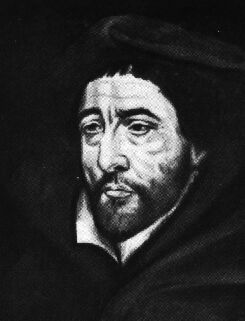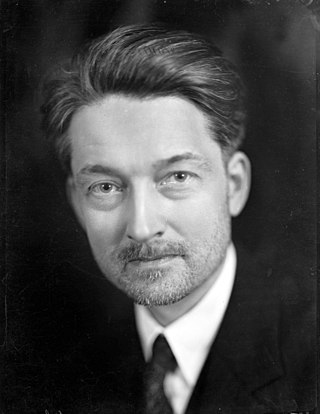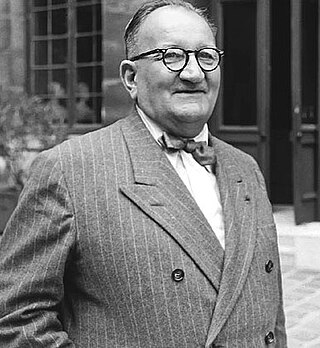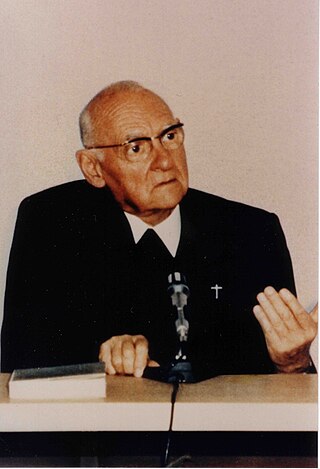Related Research Articles

Michael Baius was a Belgian theologian. He formulated the school of thought now known as Baianism.

Karl Rahner was a German Jesuit priest and theologian who, alongside Henri de Lubac, Hans Urs von Balthasar, and Yves Congar, is considered to be one of the most influential Catholic theologians of the 20th century. He was the brother of Hugo Rahner, also a Jesuit scholar.

Jacques Maritain was a French Catholic philosopher. Raised as a Protestant, he was agnostic before converting to Catholicism in 1906. An author of more than 60 books, he helped to revive Thomas Aquinas for modern times, and was influential in the development and drafting of the Universal Declaration of Human Rights. Pope Paul VI presented his "Message to Men of Thought and of Science" at the close of Vatican II to Maritain, his long-time friend and mentor. The same pope had seriously considered making him a lay cardinal, but Maritain rejected it. Maritain's interest and works spanned many aspects of philosophy, including aesthetics, political theory, philosophy of science, metaphysics, the nature of education, liturgy and ecclesiology.

Étienne Henri Gilson was a French philosopher and historian of philosophy. A scholar of medieval philosophy, he originally specialised in the thought of Descartes; he also philosophized in the tradition of Thomas Aquinas, although he did not consider himself a neo-Thomist philosopher. In 1946 he attained the distinction of being elected an "Immortal" (member) of the Académie française. He was nominated for the Nobel Prize in Literature.

Thomas Cajetan, OP, also known as Gaetanus, commonly Tommaso de Vio or Thomas de Vio, was an Italian philosopher, theologian, the Master of the Order of Preachers 1508 to 1518, and cardinal from 1517 until his death. He was a leading theologian of his day who is now best known as the spokesman for Catholic opposition to the teachings of Martin Luther and the Protestant Reformation while he was the Pope's legate in Augsburg, and among Catholics for his extensive commentary on the Summa Theologica of Thomas Aquinas.
Baianism is a term applied to the school of thought of Catholic theologian Michael Baius (1513-1589). Its foremost apologists, Baius among them, largely claimed this school and its teachings to be a return to a sort of Augustinianism, against the reliance on Scholasticism and Scholastic writings which held sway over most Catholic theologians at the time. It is the immediate historical predecessor of Jansenism, and, as with Jansenism, has been deemed non-orthodox by the Catholic Church.

Henri-Marie Joseph Sonier de Lubac, better known as Henri de Lubac, was a French Jesuit priest and cardinal who is considered one of the most influential theologians of the 20th century. His writings and doctrinal research played a key role in shaping the Second Vatican Council.

Hans Urs von Balthasar was a Swiss theologian and Catholic priest who is considered one of the most important Catholic theologians of the 20th century. With Joseph Ratzinger and Henri de Lubac, he founded the theological journal Communio. Over the course of his life, he authored 85 books, over 500 articles and essays, and almost 100 translations. He is known for his 15-volume trilogy on beauty, goodness (Theo-Drama), and truth (Theo-Logic).
The Nouvelle théologie is an intellectual movement in Catholic theology that arose in the mid-20th century. It is best known for Pope John XXIII's endorsement of its closely-associated ressourcement idea, which shaped the events of the Second Vatican Council. It existed most notably among certain circles of French and German theologians.

Neo-scholasticism is a revival and development of medieval scholasticism in Catholic theology and philosophy which began in the second half of the 19th century.
The formulary controversy was a 17th- and 18th-century Jansenist refusal to confirm the Formula of Submission for the Jansenists on the part of a group of Catholic ecclesiastical personnel and teachers who did not accept the charge that their beliefs about the nature of man and grace were heretical as the Holy See declared. In the Kingdom of France, it pitted Jansenists against Jesuits. It gave rise to French theologian Blaise Pascal's Lettres provinciales, the condemnation of casuistry by the Holy See, and the dissolution of organised Jansenism.
Henri de Saint-Ignace was a Belgian Carmelite theologian.
Jan Hessels, Jean Leonardi Hasselius or Jean Hessels was a Flemish theologian and controversialist at the University of Louvain. He was a defender of Baianism.
Juan Martínez de Ripalda was a Spanish Jesuit theologian.

Thomas Aquinas was an Italian Dominican friar and priest, an influential philosopher and theologian, and a jurist in the tradition of scholasticism from the county of Aquino in the Kingdom of Sicily.

Servais-Théodore Pinckaers OP was a noted moral theologian, Roman Catholic priest, and member of the Dominican Order. He has been especially influential in the renewal of a theological and Christological approach to Christian virtue ethics.

The Old University of Leuven was established in 1425 with Faculties of Arts, Medicine, Law; however, the university did not have a Faculty of Theology initially. In 1426 a Faculty of Canon Law was added, and at that time both Law Faculties functioned together in one Collegium utriusque iuris.
Henri Bouillard (13 March 1908 – 22 June 1981) was a French Jesuit theologian.
Pedro Descoqs was a French Jesuit and Neo-Scholastic philosopher of the Suarezian school who taught at the Jesuit scholasticate Maison Saint-Louis in Jersey. Descoqs was a supporter of Action Française and opponent of the emergent nouvelle théologie, which brought him into conflict with prominent liberal Catholic intellectuals such as Maurice Blondel and fellow Jesuits, including his students Henri de Lubac, Yves de Montcheuil, and Gaston Fessard as well as Joseph Maréchal.
Yves Moreau de Montcheuil was a Jesuit priest, philosopher, and theologian. He was a close friend of Henri de Lubac. De Montcheuil joined the French Resistance during World War II and was executed by the Gestapo.
References
- ↑ F. Kerr, Twentieth Century Catholic Theologians: From Neoscholasticism to Nuptial Mystery, (Malden, MA; Oxford: Blackwell, 2007), p. 72.
- ↑ David L. Schindler, 'Introduction', in Henri de Lubac, The Mystery of the Supernatural, (New York: Crossroad, 1998), p. xvii.
- ↑ David L. Schindler, 'Introduction', in Henri de Lubac, The Mystery of the Supernatural, (New York: Crossroad, 1998), p. xvii.
- ↑ David L. Schindler, 'Introduction', in Henri de Lubac, The Mystery of the Supernatural, (New York: Crossroad, 1998), p. xvii.
- ↑ David L. Schindler, 'Introduction', in Henri de Lubac, The Mystery of the Supernatural, (New York: Crossroad, 1998), p. xvii.
- ↑ David L. Schindler, 'Introduction', in Henri de Lubac, The Mystery of the Supernatural, (New York: Crossroad, 1998), p. xviii.
- ↑ David L. Schindler, 'Introduction', in Henri de Lubac, The Mystery of the Supernatural, (New York: Crossroad, 1998), p. xviii.
- ↑ David L. Schindler, 'Introduction', in Henri de Lubac, The Mystery of the Supernatural, (New York: Crossroad, 1998), p. xviii.
- ↑ David L. Schindler, 'Introduction', in Henri de Lubac, The Mystery of the Supernatural, (New York: Crossroad, 1998), p. xviii.
- ↑ David L. Schindler, 'Introduction', in Henri de Lubac, The Mystery of the Supernatural, (New York: Crossroad, 1998), p. xviii.
- ↑ David L. Schindler, 'Introduction', in Henri de Lubac, The Mystery of the Supernatural, (New York: Crossroad, 1998), p. xviii.
- ↑ David L. Schindler, 'Introduction', in Henri de Lubac, The Mystery of the Supernatural, (New York: Crossroad, 1998), p. xxii.
- ↑ F. Kerr, Twentieth Century Catholic Theologians: From Neoscholasticism to Nuptial Mystery, (Malden, MA; Oxford: Blackwell, 2007), p. 76.